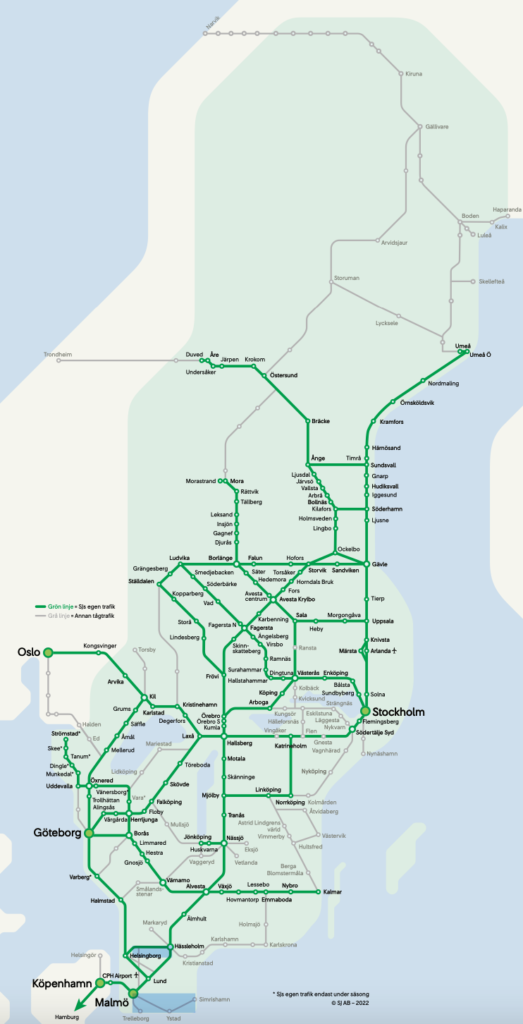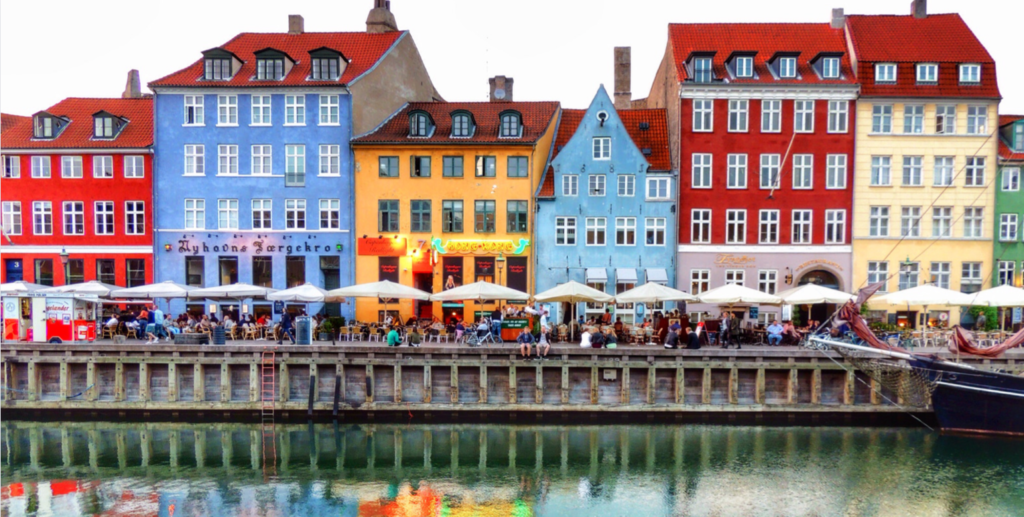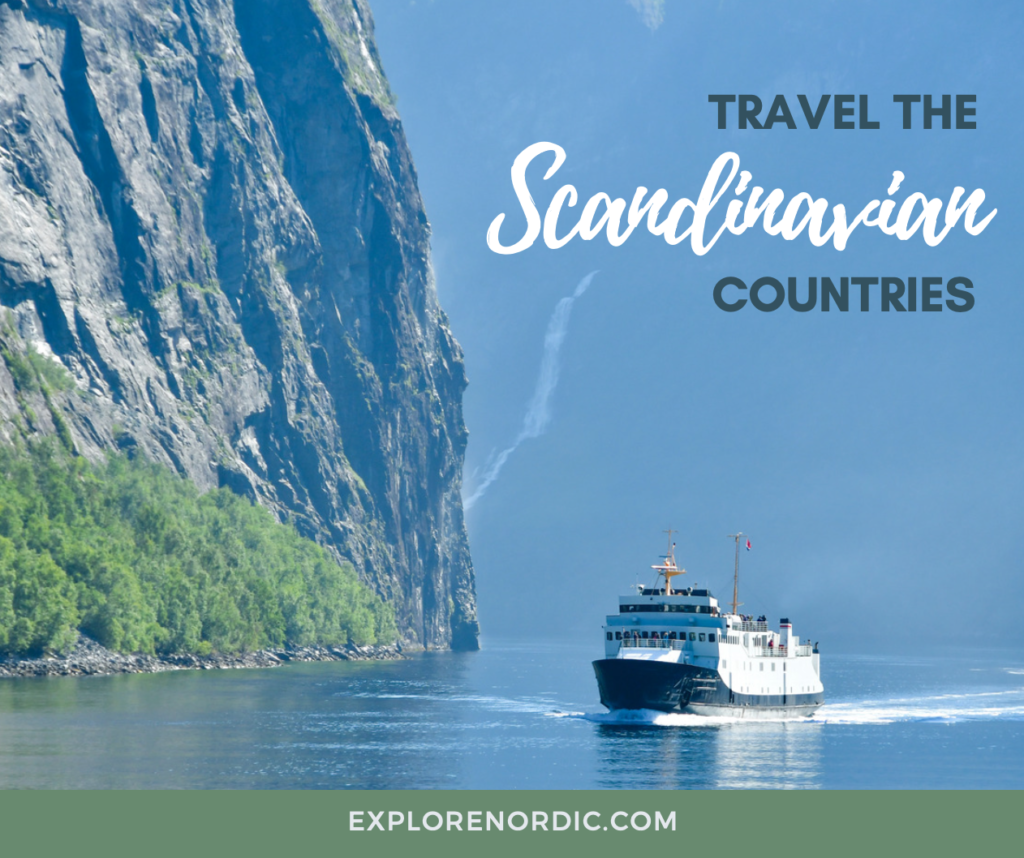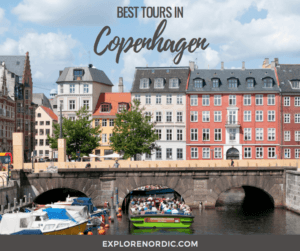Are you planning to travel the Scandinavian countries? Scandinavia is a region in Northern Europe that includes the countries of Norway, Sweden, and Denmark. In this article, we’ll include Finland as well. These countries are known for their stunning natural scenery, rich cultural heritage, and innovative design.
The region is also home to unique traditions, such as the ancient Viking culture, the Sami people of Lapland, and the Scandinavian welfare state. In recent years, the Scandinavian countries have gained a reputation for being among the most sustainable and eco-friendly nations in the world.
Despite their similarities, each country has its distinct personality and attractions, making the region a fascinating and diverse destination to explore.
In this article, we will focus on how to get around within each Scandinavian country, but also how to best travel between them.
Travel the Scandinavian Countries
There are several options for traveling around Scandinavia. Public transportation like trains and buses are commonly used. If you commute in big cities, public transportation is preferred by many. The ease of use, frequent timetables, affordable prices, and an environmentally friendly way of traveling are just a few reasons to use public transport in Scandinavia.
Let’s take a closer look at ways you can travel Scandinavia.
Travel Around Scandinavia by Car

Renting a car is a popular way to explore Scandinavia, as it allows you to travel at your own pace and visit remote areas. The region has a well-developed road network, including scenic routes such as the Atlantic Road in Norway, the Swedish West Coast Road, and the Danish Marguerite Route.
Driving in Scandinavia as a tourist can be a great way to explore the country’s stunning scenery. There are some things to keep in mind:
- Driving side: In Scandinavia, cars drive on the right-hand side of the road. Depending on where you are from, this may be different from what you’re used to in your home country.
- Road conditions: Scandinavia has a well-maintained road network, but some roads can be narrow, winding, and steep, especially in rural areas. Be prepared for challenging driving conditions and always follow the speed limit.
- Winter driving: In the winter months, Scandinavia can experience snowy and icy conditions, which can make driving challenging. Make sure you have winter tires and/or chains, and always follow the advice of local authorities regarding road closures.
- Parking: Parking can be limited and expensive in Scandinavian cities, especially in the capitals of Stockholm, Helsinki, Oslo, and Copenhagen. Consider using public transport or parking in a designated parking garage or lot.
- Wildlife: Scandinavia is home to a variety of wildlife, including moose and deer, which can sometimes wander onto roads. Be sure to watch out for wildlife and drive carefully, especially at dawn and dusk.
Tolls and Traffic Rules Driving in Scandinavia
- Tolls:
- Some roads in Norway have tolls, which can be paid using a toll tag or manually at a toll booth. Make sure you have Norwegian currency or a credit card to pay the tolls.
- Sweden has several toll roads as well, including the Stockholm congestion charge. This applies to vehicles entering Stockholm’s city center. Tolls can be paid using a pre-paid tag or manually at a toll booth.
- Denmark has several toll bridges, including the Oresund Bridge between Denmark and Sweden, and the Storebaelt Bridge between Zealand and Funen. Tolls can be paid using cash or credit card at the toll booths.
- Traffic rules: Familiarize yourself with Scandinavian traffic rules. Such as the requirement to use headlights on low beams at all times in Norway, even during the day.
- Speed limits: Speed limits are strictly enforced in Scandinavia, and fines for speeding can be high. Be sure to follow the posted speed limits and pay attention to speed cameras. Speeding fines in Norway are based on your income, so be sure to stick to the speed limit.
- Bicycles: Scandinavia, especially Denmark, is a bicycle-friendly region, and cyclists have the right of way on many roads. Be sure to watch out for cyclists and give them plenty of space when passing.
Overall, driving in Scandinavia as a tourist can be a rewarding experience, but it’s important to be prepared for the unique challenges of driving in this region.
Bus Travel
Talking about road travel, I have to mention traveling by bus. Bus travel can be a convenient and affordable option for traveling between cities in Scandinavia. Several bus companies offer connections between major cities and tourist destinations. The bus will take you further out in areas you won’t reach by train.
Getting Around Scandinavia by Train

Scandinavia has a modern and efficient rail network that connects its major cities and offers beautiful views of the region’s landscapes. The most famous train journey is the Oslo-Bergen railway in Norway. There are also scenic train routes in Sweden, such as the Inlandsbanan, and in Denmark, such as the Great Belt Bridge.
Trains in Scandinavia offer a range of seating options, from standard seats to first-class compartments. Many trains also offer free Wi-Fi and power outlets for charging electronic devices.
While trains in Scandinavia are generally reliable, delays can occur due to factors such as weather or maintenance issues. Check the train schedule before you travel, and be prepared to make alternative arrangements if necessary.
Most trains in Scandinavia are wheelchair accessible.
There are similarities between the train companies in each Scandinavian country, but there are also things that differentiate them. Let’s look at each country and who operates the train routes.
Getting Around Norway by Train
Taking the train in Norway is a popular and convenient way to travel, with comfortable and modern trains running throughout the country. Here are some things to keep in mind when taking the train in Norway:
- Routes: Norway’s national train operator, Vy, operates train services throughout the country, with routes connecting major cities and scenic destinations. Some of the most popular routes include the Bergen Line and the Rauma Line.
- Tickets: Tickets can be purchased online or at train stations. Vy offers several ticket options, including one-way, round-trip, and multi-trip tickets.
- Scenic views: Taking the train in Norway is a great way to experience the country’s stunning natural scenery. Many routes offer breathtaking views of mountains, fjords, and forests.
Getting Around Denmark by Train
Taking the train in Denmark is convenient, with a modern and efficient rail network operated by the national train company, DSB. Here are some things to keep in mind when taking the train in Denmark:
- Routes: DSB operates train services throughout the country. The most popular routes include the Copenhagen-Aarhus route and the Copenhagen-Odense route.
- Tickets: Tickets can be purchased online or at train stations. DSB offers several ticket options, including one-way, round-trip, and multi-trip tickets. It’s usually cheaper to purchase tickets in advance, and you can often save money by booking through the DSB website.
Getting Around Sweden by Train

Taking the train in Sweden is convenient. The rail network operated by the national train company is SJ (Statens Järnväg). Here are some things to keep in mind when taking the train in Sweden:
- Routes: SJ operates train services throughout the country. The most popular routes include the Stockholm-Gothenburg route and the Stockholm-Malmö route.
- Tickets: You can purchase tickets online or at train stations. SJ offers several ticket options, including one-way, round-trip, and multi-trip tickets. It’s cheaper to purchase tickets online through the SJ website in advance.
- Scenic views: Taking the train in Sweden is a great way to experience the country’s stunning landscapes, with many routes offering picturesque views of the countryside and coastlines.
- High-speed trains: Sweden also has several high-speed train services, including the X2000 and SJ3000 trains, which offer fast and efficient travel between major cities.
- Night trains: Sweden has some overnight train services, which offer comfortable sleeping compartments for long-distance journeys.
Getting Around Finland by Train
Taking the train in Finland is easy and convenient. A well-developed rail network operated by the national train company, VR. Here are some things to keep in mind when taking the train in Finland:
- Routes: VR operates train services throughout the country. The most popular routes include the Helsinki-Tampere route and the Helsinki-Oulu route.
- Tickets: Tickets can be purchased online or at train stations. VR offers several ticket options. It’s usually cheaper to purchase tickets in advance, and you can often save money by booking through the VR website.
- Night trains: Finland also has several overnight train services, which offer comfortable sleeping compartments for long-distance journeys.
Overall, taking the train in Scandinavia is a comfortable and convenient way to travel. There will be plenty of opportunities to take in the regions natural beauty along the way.
Ferry Travel in Scandinavia

Scandinavia’s long coastline and many islands make ferry travel a popular option. Several ferry companies operate between the countries, such as Stena Line, DFDS Seaways, and Viking Line. There are also many ferry companies operating domestically. Fjords in Norway and the Stockholm archipelago, for example, are best enjoyed from the water. Some ferry routes offer scenic views of the region’s coastlines and archipelagos.
Some ferry routes to consider are:
- Helsinki, Finland – Stockholm, Sweden
- Helsingborg Sweden – Helsingor Denmark
- Copenhagen, Denmark – Oslo, Norway
- Hurtigruten the west coast of Norway
- Gothenburg, Sweden – Fredrikshavn Denmark
Below we dive a little deeper into a couple of these common ferry routes.
Bicycle
When talking about transportation in Scandinavia we just have to mention biking. Cycling is a popular way to explore Scandinavia, especially in the summer months when the weather is mild. There are several cycling routes, such as the Kattegattleden in Sweden. Also, the North Sea Cycle Route that passes through Denmark, Norway, and Sweden, and the Rallarvegen in Norway, are popular biking routes.
Join a Group Tour
Joining a group tour traveling Scandinavia can be a great way to experience the region. It allows you to explore the sights with the guidance of an expert tour guide and the company of other like-minded travelers.
Depending on the tour, transportation may be provided by coach, train, or boat. You can expect to travel with the other members of your group and to have a comfortable and convenient mode of transportation throughout your trip. This is a convenient and easy way to travel Scandinavia.
Here is an example of a 16 days Scandinavian Capitals including the Norwegian Fjords, a small group tour.
How to Best Travel Between the Scandinavian Capitals
- Helsinki – Stockholm
- Stockholm – Copenhagen
- Copenhagen – Oslo
Travel Between Helsinki – Stockholm
The best way to travel between Helsinki and Stockholm is by ferry or by flight. The ferry option will take longer, but it’s a fun experience. Here are some details on both options:
Ferry between Helsinki and Stockholm
The ferry route between Helsinki, the capital city of Finland, and Stockholm, the capital city of Sweden, is a popular option for travel between the two countries. Here is some information about the ferry service:
- Operators: Several ferry operators offer services between Helsinki and Stockholm, including Tallink Silja, Viking Line, and Finnlines.
- Duration: The duration of the ferry ride varies depending on the operator and the type of ferry. The journey can take anywhere from around 16 to 18 hours.
- Frequency: The frequency of the ferries depends on the season and the operator, but generally, there are multiple sailings per day, especially during peak season.
- Amenities: The ferries are generally well-equipped and offer a range of amenities, such as restaurants, cafes, bars, shops, and entertainment. You can enjoy live music, movies, and casinos. Some ferries also have swimming pools, saunas, and spas.
- Accommodation: Most ferries offer a range of accommodation options. These include cabins of different sizes and classes, from basic inside cabins to luxurious suites. Some ferries also have shared cabins and couchettes.
- Cost: The cost of the ferry ticket varies depending on the operator, the type of ferry, and the time of year. Generally, the cost ranges from around 50-100 euros for a basic ticket to several hundred euros for a luxury suite.
- Immigration: As both Finland and Sweden are part of the Schengen area, there are generally no immigration formalities when traveling by ferry between Helsinki and Stockholm.
Overall, the ferry route between Helsinki and Stockholm is a convenient and comfortable way to travel between the two cities, offering a range of amenities and accommodation options.
Fly Helsinki – Stockholm
Several flights operate between Helsinki and Stockholm each day, with a travel time of approximately 1 hour. Flights are operated by several airlines, including Finnair, SAS, and Norwegian.
This option is generally faster and more convenient than the ferry, but you’ll miss out on the scenic journey across the Baltic Sea.
Both options offer their unique advantages and disadvantages, so it’s up to you to decide which option is best suited to your needs and preferences. If you have plenty of time and enjoy the sea journey, the ferry can be a great option. If you prefer a faster and more efficient travel option, then flying is the way to go.
Travel Between Stockholm – Copenhagen
The best way to travel between Stockholm and Copenhagen is by flight or train. Several flights operate between Stockholm and Copenhagen each day, with a travel time of approximately 1 hour. Flights are operated by several airlines, including SAS and Norwegian. This option is generally faster and more convenient than the train, but you’ll miss out on the scenic journey across southern Sweden.
Frequent train services are running between Stockholm and Copenhagen, with a travel time of approximately 5-6 hours. The train journey takes you through the picturesque southern part of Sweden and across the Øresund Bridge, which connects Sweden and Denmark. The train service is operated by SJ, the Swedish national rail company, and tickets can be booked online.
If you’re short on time and prefer a faster travel option, then flying is the way to go. If you enjoy scenic train journeys and have more time to spare, then taking the train is a great option.
Travel Between Copenhagen to Oslo
Overall, the best option for you depends on your preferences and budget. Flying is the fastest but can be expensive. Taking the ferry can be a more scenic option, but it takes longer. Taking the train is a comfortable option, but it also takes a bit longer. Whatever option you choose, all three modes of transportation offer their unique advantages and experiences.
Ferry between Copenhagen and Oslo
The ferry service between Copenhagen and Oslo is operated by DFDS Seaways, one of the largest ferry operators in Northern Europe. The ferry departs from Copenhagen’s port, located in the district of Nordhavn, and arrives at Oslo’s port, located in the city center.
The journey takes approximately 17 hours, and the ferry operates daily throughout the year. The ferry offers a range of cabins, from standard cabins to luxury suites. Amenities include restaurants, bars, shops, and entertainment facilities. The ferry route offers a unique travel experience, with stunning views of the Danish and Norwegian coasts. You’ll also get the chance to see the beautiful Oslofjord as you approach the Norwegian capital in the morning.
It’s a convenient option if you prefer to travel overnight and wake up in a new destination, or if you want to bring your car with you. Ticket prices vary depending on the time of year and cabin type, so it’s best to check the DFDS Seaways website for up-to-date information and booking options.
Fly Copenhagen to Oslo
Several flights operate between Copenhagen and Oslo each day, with a travel time of approximately 1 hour and 20 minutes. Flights are operated by several airlines, including SAS and Norwegian.
Several train services run between Copenhagen and Oslo, with a travel time of approximately 8-9 hours. The train journey takes you through the scenic countryside of southern Sweden and part of Norway. The train service is operated by SJ and NSB, the national rail companies of Sweden and Norway, and tickets can be booked online. You usually have to switch trains in Gothenburg, the second largest city in Sweden. If you have time take a stroll in this beautiful city or maybe even spend the night.
Traveling Around Scandinavia, What Can You Expect to See?

Scandinavia is known for its stunning natural scenery, including fjords, mountains, forests, and lakes. Some of the most beautiful natural attractions include Norway’s Geirangerfjord, Sweden’s Abisko National Park, and Denmark’s Mols Bjerge National Park.
Scandinavia has a rich history and cultural heritage. Visitors can explore ancient Viking ruins, medieval castles, and modern Scandinavian design. Some of the most notable cultural attractions include the Viking Ship Museum in Oslo, Denmark’s Kronborg Castle, and Sweden’s Skansen open-air museum.
The region offers a wide range of outdoor activities, such as hiking, skiing, fishing, and biking. Visitors can also experience unique adventures, such as dog sledding in Lapland, kayaking in the fjords, and whale watching in Norway.
The countries has a diverse and innovative culinary scene. Visitors can try traditional Scandinavian dishes like smoked salmon, reindeer, and meatballs. As well as modern Nordic cuisine, which emphasizes local and seasonal ingredients. Scandinavia is also known for its craft beers and aquavit, a traditional Scandinavian spirit.
Scandinavia is a leader in sustainability and eco-tourism. Visitors can explore eco-friendly hotels, restaurants, and attractions, and learn about sustainable living practices.
There are many reasons to visit this beautiful region and travel to the Scandinavian countries. How will you get around? What are you planning to explore on your next trip? Please share below, I would love to hear from you.






